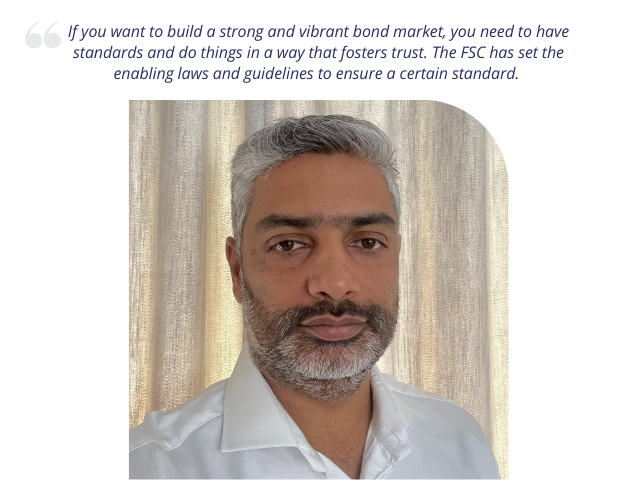The FSC guidelines on corporate and green bonds work to ensure that the right issuers use the Mauritius IFC and investors feel comforted with these standards being implemented, according to Dean D’Sa, Founding Partner at IZAR. Dean advised on the issuance of green bonds worth MUR 500 million for CIM Financial Services Ltd (CFSL), as a first for the island economy which is rapidly cementing its position as a hub for raising finance in Africa.

As a leading corporate finance advisor with green bond credentials in Mauritius, could you tell us how the legal infrastructure in the island economy has evolved over the last year – starting with the industry consultation for the issuance of green and corporate bonds by the FSC?
The legal infrastructure has not changed which is good because when structuring deals, you really want to have the comfort of stability. That being said, the Mauritius IFC has been enhanced thanks to the proactiveness of the Financial Services Commission (FSC) Mauritius which realised that Mauritius is rapidly cementing its position as a hub for raising finance in Africa. As part of their efforts to support this development, the FSC engaged with stakeholders when they developed guidelines on the issuance of corporate and green bonds.
This approach has resulted in a set of guidelines that works to ensure that the right issuers use the IFC and importantly investors feel comforted with these standards being implemented.
How have the efforts of IZAR progressed in terms of the development of a corporate bond market in Mauritius with specialization in green funding, especially as a recent milestone was the issuance of green bonds worth MUR 500 million for one of Mauritius’ leading conglomerates, CIM Financial Services Ltd (CFSL), as the first for the island economy?
I founded IZAR with the mission of helping to bring high quality transactions to investors. That is how we differentiate ourselves from other advisors. We are very hands on with respect to assisting clients. We understand the various legislations applicable to potential issuers but we also vet our transactions to ensure we work with issuers that are very strong and meet our own credit assessment.
If you build a house, you have to build it on strong foundations. The same thing applies with bond markets. If you want to build a strong and vibrant bond market, you need to have standards and do things in a way that fosters trust. The FSC has set the enabling laws and guidelines to ensure a certain standard.
I have wanted to introduce green bonds to Mauritius for a couple of years now but had to wait until the right opportunity presented itself in terms of timing and specifically issuer. We have been excited to work with the CIM team to do this green bond because they have a very strong brand and a very good credit rating (AA-).
Could you tell us about the steps involved in putting together the green bond framework for CFSL, including the level of interaction required with the FSC for standard setting?
To develop the green bond framework, we first had to work with CIM to understand their business and sustainability ambitions. This then allowed us to understand that what CIM wanted to do was raise money through the issuance of green bonds and then lend that out to its clients so that they could help persuade their clients to make more sustainable consumption decisions. We therefore looked at what CIM’s clients could purchase and which UN Sustainable Development Goals these products could align with.
Once we identified what CIM clients could purchase with financing from CIM, we then needed to build a way of calculating metrics to show the sustainability contributions that this debt was enabling. To do this we collaborated with environmental specialists Dynamia Associates to identify attributes like GHG emissions reduced annually, annual renewable energy generations, carbon intensity of the bond, etc. As per the FSC guidelines on green bonds, we then had to get this green bond framework audited by an external verifier before we could issue the bonds.
The Green Bond Framework identifies five categories of projects that can deliver positive and sustainable results for the country and are likely to be financed by the proceeds of these green bonds. Could you tell us about the five categories, and which of these are specifically touched upon by the CFSL transaction?
The green bond framework that you mention is available in the investor relations section of CIM’s website. CIM focuses on all five categories because we specifically developed this framework for them. Each issuer would typically have their own customized green bond framework. Different issuers will have varying opinions on what they believe is green and not green. This is why the FSC guidelines on green bonds are so important. They set a minimum standard for green bonds.
Beyond that, it is up to the issuers and their advisors to determine how they want to be perceived with respect to their green credentials. Obviously the more credible the level of greenness, the better value delivered to the issuers brand and also there is likely to be some benefit in terms of pricing of that debt.
How was the experience of doing a road show for the transaction? It was clear that there was phenomenal demand for this innovative and sustainable funding mechanism, so how did your team handle such overwhelming demand?
This is where IZAR’s mission statement really delivers. We waited for the right Issuer to launch green bonds in Mauritius. When we started working on this transaction, we approached certain investors who, like us, have a vested interest in developing Mauritian bond markets in the right way. These investors were ready to take the whole first tranche of green bonds being issued by CIM and so we did not go speak to many others.
We know there are more investors who would have liked to get some sustainable debt into their portfolio and we will be approaching them with the next tranche for sure.
At a client level, how was the exercise of assessing the CFSL business and identifying green activities and exclusions, comparing them to the UN Sustainable Development Goals, doing a cost-benefit analysis of going green and working with the team to develop a business case for greater green credentials?
This was a really exciting project for the IZAR team because we worked with the client to build something new that would be competitive in the domestic market because of our bottom up approach to putting this transaction together. Debt transactions are complex and require a special skill set. Green bonds add an extra layer of difficulty because you need build a green bond framework which has credibility.
We are lucky to work with some very strong teams at Dynamia Associates (sustainability experts) and Benoit Chambers (legal advisors).
Finally, when we speak of green finance, blue finance can never be far behind. Could you share your views on the evolution of blue finance in the region, and how such developments are affecting Mauritius?
I think the development of blue bonds will gain traction once green bonds and sustainability linked bonds become more prevalent. I believe that the development of the blue bond market will unfortunately be held back by the following limiting factors:
- There are a limited number of companies that have a vested interest to issue a blue bond (use of proceeds is linked to the blue economy).
- Projects in this space tend to be small so it makes it hard to cover the costs associated with a blue bond issuance.
As a result, corporate involvement in the blue bond space will be limited and thus it would tend to be a space driven by government issuance.
Mauritius may be well placed to become a regional hub for blue bond issuance thanks to the guidelines to sovereigns on sustainable debt issued by the Bank of Mauritius and the various island economies around it that do not have the same level of infrastructure in their debt capital markets.
